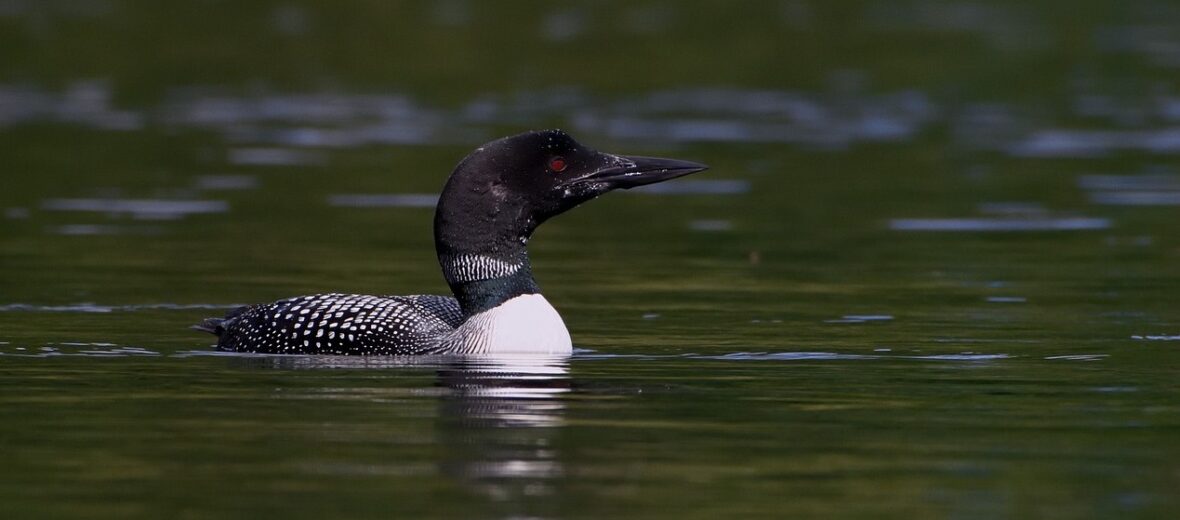
Getting their name from the way they clumsily walk on land, it’s the common loon. There are 4 known species of loon: Pacific, red-throated, Arctic, and yellow-billed. They may look awkward on land, due to their legs being positioned too far to the rear of their bodies but they are excellent swimmers and divers because of this leg positioning. The common loon breeds in forested lakes and large ponds in Iceland, Greenland, and the northern parts of North America. In the winter, they live along the Pacific and Atlantic coasts of Iceland, Europe, and North America. Loons are listed as Least Concern by the IUCN.
First the Stats…
Scientific name: Gavia immer
Weight: Up to 18 lbs.
Length: Up to 3 feet
Wingspan: Up to 53.5 inches
Lifespan: Over 30 years
Now on to the Facts!
1.) A common loon can dive over 200 feet below the water’s surface, in search of a tasty meal.
2.) On land, loons kind of stumble about and push themselves along on their stomachs. Hence why they tend to stay in the water. Evolution can be a cruel mistress.
3.) Even though they are clumsy on land, they are not only skilled at swimming, but flying as well. They can even reach speeds of up to 70 mph in the air!
4.) Unlike many birds, loons have solid bones which make them less buoyant. They also conserve oxygen underwater by slowing their heartbeat. These birds have the ability to flatten their feathers quickly to become more streamlined.
5.) They sometimes need up to a 600 feet for taking off in water. That’s quite a runway.
But wait, there’s more on the common loon!
6.) Loons are an indicator species. They only hang out if the water quality is crystal-clear. This makes it easier for them to see prey underwater. If the water quality is bad, they will avoid it altogether.
7.) Common loons have 4 distinct calls: The wail, a long, haunting bellow that sounds like the howl of a wolf; the yodel; and the tremolo is a cackle that loons make when they feel threatened or are feeling territorial (this sounds like maniacal laughter); and finally, the hoot.
Did you know…?
In 1986, the Royal Canadian mint was getting ready to start mass producing their dollar coins. The front was to have Queen Elizabeth and the back was to have 2 people in a canoe. Well, the canoe die was lost. So as a last minute switcherooo, they created a die of the common loon. It’s now beloved by Canadians and revered by hockey players as a lucky coin.
8.) In the winter, their eyes are a dull gray. But in the spring and summer, they turn a bright red.
9.) Like many birds, loons will intentionally eat small rocks to aid in the digestion process, since they swallow their food whole (due to not having any teeth). These are called gastroliths.
10.) Loon chicks will ride on their mom’s back for safety for about a week or so. Once they reach 2 – 3 years old, they are able to look after themselves and leave to start life out on their own.
But wait, there’s still more on the common loon!
11.) Loons are more closely related to penguins and albatrosses than to geese or ducks.
Did you know…?
Mercer, Wisconsin touts itself as being the loon capital of the world.
12.) They eat fish, crayfish, shrimp, and even leeches!
13.) Loons are monogamous (mate for life).
14.) Females lay 1 – 2 eggs each season.
Now a Short Common Loon Video!
Also, check out the Critter Science YouTube channel. Videos added frequently!
Want to suggest a critter for me to write about? Let me know here.



